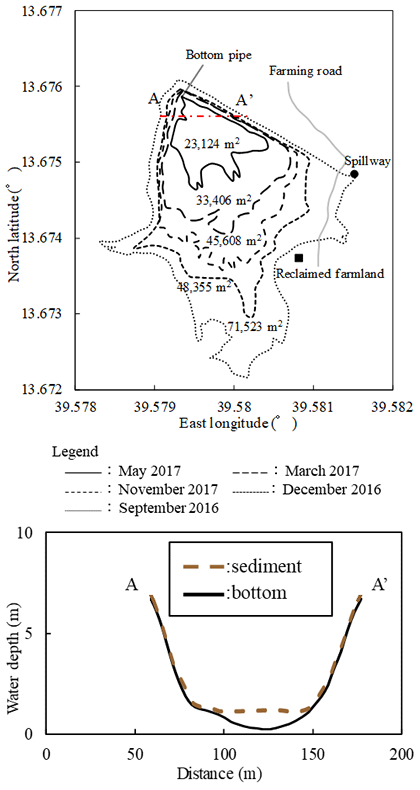Farmland reclamation using micro-dam sediments in the Ethiopian Highlands
Description
The Ethiopian Highlands in the eastern part of sub-Saharan Africa typically experience semi-arid climatic conditions, with rainfall during rainy seasons causing severe soil erosion. Ninety-two (92) micro-dams have been constructed at micro-watersheds in Tigray, Ethiopia, more than half of which undergo sedimentation due to gully erosion, consequently decreasing the amount of available water. Sediment accumulation in micro-dams is considered a serious problem affecting irrigation water supply and crop cultivation (Berhane et al., 2016). Although it is an urgent challenge to remove the sediments from micro-dams, it is difficult to deal with, thus the problem remains unsolved. The purposes of this research are to estimate the storage water and sediment volume in a typical micro-dam at a micro-watershed in this region and to test the feasibility of using the sediments for farmland reclamation.
The Adizaboy micro-dam is located at the outlet of the steep Adizaboy micro-watershed (8.5 km2). Weather conditions and water depths in Adizaboy micro-dam were automatically recorded. The storage volume change was assumed to be zero (0) for one year. Potential available water was calculated using the water balance analysis of Adizaboy micro-dam (Fig. 1). A new bathymetric survey method was applied to estimate the sediment volume in the micro-dam. The geographic coordinates along the water surface perimeters and the storage water depths were noted (Fig. 2, top). Sediment volume between observed sediment surface and estimated bottom surface was calculated (Fig. 2, bottom). Bare lands were cleared at the end of dry season (an agricultural off-season), when there was no storage water in the micro-dam. Sediments were excavated manually and transported using farm animals. A farmland was reclaimed by forming layers of stones and sediments (Fig. 3).
The reclaimed farmland will be managed by Wareda (the villagers’ group) and provided for free to some young landless farmers to create employment opportunities. By cultivating vegetables with high market value, the reclaimed farmland is expected to generate a cash income source and improve the living standard of residents. Onion yield in the reclaimed farmland of 11.93 t/ha is almost same as the national average (10.38 t/ha). It is thus necessary to construct a farm pond for irrigation to enable vegetable cultivation during the dry season. To extend the technology, it would be practical to use past experiences and knowledge of participants in cooperation with local governments, universities, and residents in the selection of sites, earth works, and construction of additional facilities etc. This method of estimating the volume of sediments is applicable to other micro-dams.
Figure, table
-
Fig. 1. Water balance of Adizaboy micro-dam
The storage volume of the micro-dam is 200,000m3.
Available water is assumed to be the sum of water leakage through the foundation rock and the embankment, the flood water over the spillway, and the spring water downstream. -
Fig. 2. Changes in water storage area and cross-sectional view of Adizaboy micro-dam
Top: changes in water storage area, Bottom: cross sectional view
The numbers in the top figure show the water storage areas (in m2). The water depth in the bottom figure displays the height from the lower edge of the bottom pipe inlet. The sediment volume of Adizaboy micro-dam is estimated to be 6,400 m3. In case the thickness of the reclaimed farmland is 0.2 m, the reclaimable farmland area is 3.2 ha. It would also be effective if some of the sediments are removed and used for reclamation before the bottom pipe gets buried and malfunctions. -
Fig. 3. The reclaimed farmland using sediments from Adizaboy micro-dam
Top: before reclamation, Bottom: after reclamation
- Affiliation
-
Japan International Research Center for Agricultural Sciences Rural Development Division
- Classification
-
技術
- Research project
- Program name
- Term of research
-
FY2019 (FY2016-FY2020)
- Responsible researcher
-
Kouda Kazuhisa ( Rural Development Division )
MIERUKA ID: 001756Girmay Gebrayohannes ( College of Dryland Agriculture and Natural Resources Management, Mekelle University )
Berihu Tesfay ( College of Dryland Agriculture and Natural Resources Management, Mekelle University )
- ほか
- Publication, etc.
-
https://doi.org/10.3390/su11072038
Koda K et al. (2019) Sustainability, 11(7):2038
- Japanese PDF
-
2019_A03_A4_ja.pdf1017.96 KB
2019_A03_A3_ja.pdf318.7 KB
- English PDF
-
2019_A03_A4_en.pdf680.85 KB
2019_A03_A3_en.pdf189.16 KB
- Poster PDF
-
2019_A03_poster_fin.pdf422.82 KB



